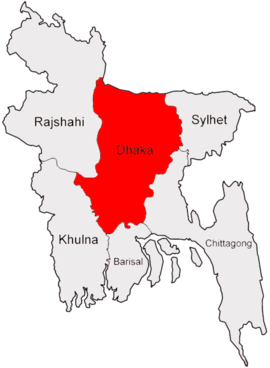Daulatpur–Saturia tornado
The Daulatpur–Saturia tornado occurred in Manikganj District, Bangladesh on April 26, 1989. It was the deadliest tornado in Bangladesh's history. There is great uncertainty about the death toll, but estimates indicate that it was devastating and that it killed approximately 1,300 people, which would make it the deadliest tornado in history.[1] The tornado affected the cities of Daulatpur and Saturia the most, moving east through Daulatpur and eventually northeast and into Saturia.[1] Previously, the area that the tornado hit had been in a state of drought for six months.[1]
| F3 tornado | |
|---|---|
 Dhaka, the area hit by the tornado | |
| Formed | 12:30 UTC on April 26, 1989 |
| Max. rating1 | F3 tornado |
| Casualties | 1,300 fatalities (estimated) 12,000 injuries |
| Areas affected | Manikganj, Dhaka, Bangladesh |
| 1Most severe tornado damage; see Fujita scale | |
Background
The Ganges Basin, comprising the entirety of Bangladesh, is frequented by severe weather.[2] Such storms that are capable of producing tornadoes in this region are most common during the pre- and post-monsoon months.[3] An average of six tornadoes occur annually in Bangladesh, with peak activity in April.[4] The pre-monsoon months (March to May) display the most favorable conditions for severe weather. During this time, convective available potential energy—an indicator of atmospheric instability whereby higher values denote a greater likelihood of thunderstorms—and wind shear are conducive to the development of rotating thunderstorms.[5] Instability is greatest over West Bengal, India, and adjacent areas of Bangladesh. Storms frequently develop in this region and travel southeast across the country. These storms are locally referred to as norwesters or Kalbaishakhi.[6]
Event and aftermath
On April 25, 1989, a 1000 mbar (hPa; 29.53 inHg) area of low pressure propagated over Bihar and West Bengal, India, with a trough extending east across Bangladesh and into Manipur, India. The system remained largely stationary throughout the day into April 26. On that day, another low approached from Madhya Pradesh, and in conjunction with a ridge over China, the pressure gradient became tighter across Bangladesh. Warm, moist air flowed northeast from the Bay of Bengal while cool, dry air flowed south from the Himalayas. In the upper-levels of the atmosphere above the low, strong westerly winds from the jet stream created ample wind shear, a key factor in the development of supercell thunderstorms of producing tornadoes. The jet stream became particularly intense on April 26, with a sounding from Dhaka observing 240 km/h (150 mph) winds at a height of 10.6 km (35,000 ft). An established dry line over western Bangladesh served as a focal point for thunderstorm development. By 12:00 UTC, all the aforementioned factors served to produce severe thunderstorms across the country.[7]
Around 12:30 UTC, a tornado touched down near Daulatpur in the Manikganj District and traveled east, soon striking Saturia. It caused tremendous damage across a 150 km2 (58 sq mi) area covering three upazilas, with Saturia being hardest-hit.[7][8] Its path was about 80 km (50 mi) long.[9] A World Meteorological Organization news letter noted the tornado as F3.5 on the Fujita Scale. However, the stated wind estimate of 338 to 418 km/h (210 to 260 mph) would rank it as an F4.[7][10]
It killed roughly 1,300 people and injured 12,000.[8] Damage was extensive, as countless trees were uprooted and every home within a six square kilometer area of the tornado's path was completely destroyed.[1] An article in the Bangladesh Observer stated, "The devastation was so complete, that barring some skeletons of trees, there were no signs of standing infrastructures".[1] Approximately 80,000 people were left homeless.[9] A second tornado struck the Narsingdi District, killing 5 people and injuring 500 others.[8]
See also
- List of tornadoes and tornado outbreaks
- List of Asian tornadoes and tornado outbreaks
- Tri-State Tornado – The deadliest tornado recorded in the United States
- 1996 Bangladesh tornado
References
- Finch, Jonathan; Dewan, Ashraf M. "Tornados in Bangladesh and East India –—". Bangladesh tornadoes. Retrieved 2008-08-23.
- Smriti Mallapaty (12 April 2019). "Nepali scientists record country's first tornado". Nature. doi:10.1038/d41586-019-01159-w. PMID 32277167. Retrieved 23 April 2019.
- Peterson, R. E.; Mehta, K. C. (December 1981). "Climatology of tornadoes of India and Bangladesh". Archive for Meteorology, Geophysics and Bioclimatology, Series B. 29 (4): 345–356. Bibcode:1981AMGBB..29..345P. doi:10.1007/BF02263310.
- Paul, Bimal Kanti; Bhuiyan, Rejuan Hossain (2014). "The April 2004 Tornado in North-Central Bangladesh: A Case for Introducing Tornado Forecasting and Warning Systems" (PDF). University of Colorado. Retrieved August 8, 2019.
- Yamane, Yusuke; Hayashi, Taiichi; Dewan, Ashraf Mahmmood; Akter, Fatima (March 2010). "Severe local convective storms in Bangladesh: Part I. Climatology". Atmospheric Research. 95 (4): 400–406. Bibcode:2010AtmRe..95..400Y. doi:10.1016/j.atmosres.2009.11.004.
- Karmakar, Samarendra; Mannan, Abdul; Quadir, Dewan Abdul (July 2015). "Trends in maximum temperature and thunderstorms, their correlation and impacts on the livelihood of Bangladesh". Atmosphere. 5 (1): 113–129.
- Hossain, Akram; Karmakar, Samarendra (1998). "Some Meteorological aspects of the Saturia tornado, 1989—A case study". Journal of Bangladesh Academy of Sciences. 22 (1): 109–122.
- Angwin, Richard (28 April 2014). "The deadliest tornado remembered". Al Jazeera. Retrieved 2 May 2019.
- Cerveny, Randy (2006). Freaks of the Storm: From Flying Cows to Stealing Thunder: The World's Strangest True Weather Stories. New York: Thunder's Mouth Press. p. 272. ISBN 1-56025-801-2.
a tornado cut a long track, up to a mile wide, through about fifty miles of the poor country [Bangladesh]. The Bangladeshi towns of Salturia [sic] and Manikganj were leveled and about eighty thousand people were left homeless.
- Edwards, Roger; LaDue, James G.; Ferree, John T.; Scharfenberg, Kevin; Maier, Chris; Coulbourne, William L. (May 2013). "Tornado Intensity Estimation: Past, Present, and Future". Bulletin of the American Meteorological Society. 94 (5): 641–653. Bibcode:2013BAMS...94..641E. doi:10.1175/BAMS-D-11-00006.1. eISSN 1520-0477. ISSN 0003-0007. S2CID 7842905.